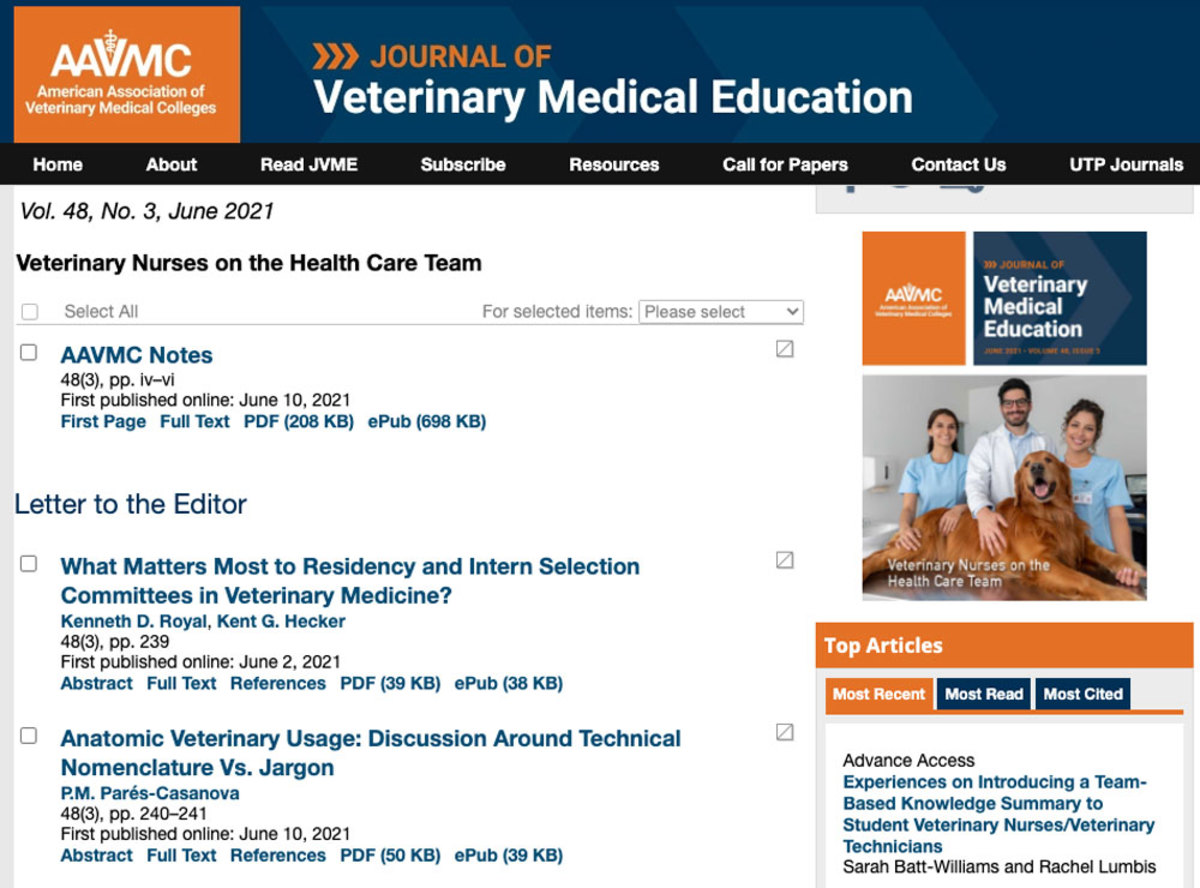
The American Association of Veterinary Medical Colleges (AAVMC) and the University of Toronto Press are pleased to announce that beginning in July 2021, the Journal of Veterinary Medical Education (JVME) has adopted a hybrid print and online publishing model that incorporates open access of all published content.
Effective July 1, 2021, all JVME content is published with a 12-month open access embargo and all issues published up to and including volume 47 issue 3 (June 2020) are now open access at jvme.utpjournals.press.
This change expands access to important developments in veterinary medical education. JVME’s transition to a hybrid publishing model amplifies its global reach to veterinary medical practitioners, educators, researchers, prospective and current veterinary medical students and other stakeholders.
Under the new model, JVME will maintain a rolling 12-month embargo on new issues. Based on the date of issue publication, and at no cost to authors, all articles will become open access directly on the journal’s website 12 months after publication. During the first 12 months of publication, content will remain available to members of the AAVMC and by subscription to both library and individual customers. Faculty and students of AAVMC member institutions and subscribing libraries have access to all content available by subscription.
As an additional option, authors may choose, with payment of a fee, to publish individual manuscripts using the gold open access model, whereby the manuscripts will be published open access immediately after acceptance, without an embargo. The journal’s Advance Online feature will be maintained under the new model.
Shifting the JVME to a hybrid model will foster AAVMC’s goals of building public awareness of the ways veterinary medicine is advancing global health and wellbeing; promoting careers in veterinary and biomedical research among students, applicants and pre-applicants; and supporting engagement, sharing and collaboration among AAVMC member institution research administrators.
Increased visibility and more timely access to the research presented in JVME will also promote interprofessional collaboration and improve outreach to the media and policy-makers, further increasing the impact of JVME and its authors on international veterinary medicine.
While addressing the rapidly changing world of veterinary medicine, JVME remains strongly committed to ensuring that the highest ethical standards are honored in all areas of published research. Rigorous peer-review processes will maintain the high-quality trusted research for which JVME is known and respected.
This move is the latest effort in JVME’s mission to continuously improve its service to the academic veterinary medical community. In 2020, JVME increased the annual number of issues published from four to six in response to the steady increase of high-quality scholarly manuscripts and the need for rapid access to crucial research within the veterinary medical education field.
About the Journal of Veterinary Medical Education
Published bi-monthly by the AAVMC and the University of Toronto Press, the JVME provides a forum for the exchange of ideas, research and discoveries about veterinary medical education. This exchange benefits veterinary faculty, students, and the veterinary profession as a whole by preparing veterinarians to better perform their professional activities and to meet the needs of society. The journal’s areas of focus include best practices and educational methods in veterinary education; recruitment, training, and mentoring of students at all levels of education, including undergraduate, graduate, veterinary technology, and continuing education; clinical instruction and assessment; institutional policy; and other challenges and issues faced by veterinary educators domestically and internationally. To sign up to receive important news relating to Journal of Veterinary Medical Education visit bit.ly/JVMEnews.
About the AAVMC
The member institutions of the American Association of Veterinary Medical Colleges (AAVMC) promote and protect the health and wellbeing of people, animals and the environment by advancing the profession of veterinary medicine and preparing new generations of veterinarians to meet the evolving needs of a changing world. Founded in 1966, the AAVMC represents more than 40,000 faculty, staff and students across the global academic veterinary medical community. Our member institutions include Council on Education (COE) accredited veterinary medical colleges and schools in the United States, Canada, Mexico, Europe, Asia, Australia and New Zealand as well as departments of veterinary science and departments of comparative medicine in the U.S..
About University of Toronto Press
Founded in 1901, University of Toronto Press is one of the largest university presses in North America. The Journals Division has been an important part of the Press since its foundation and has built a strong reputation for excellence in scholarship and innovation in publishing. We work hand-in-hand with researchers, scholars, editors and scholarly societies to publish 40+ journals in a variety of disciplines, including medicine, the social sciences and humanities. We are passionate about high-quality content, digital distribution, and the success of scholarly journals and are making major strides forward in areas such as online peer review systems and multimedia publishing, such as videos and podcasts. For more information visit utpjournals.press.








